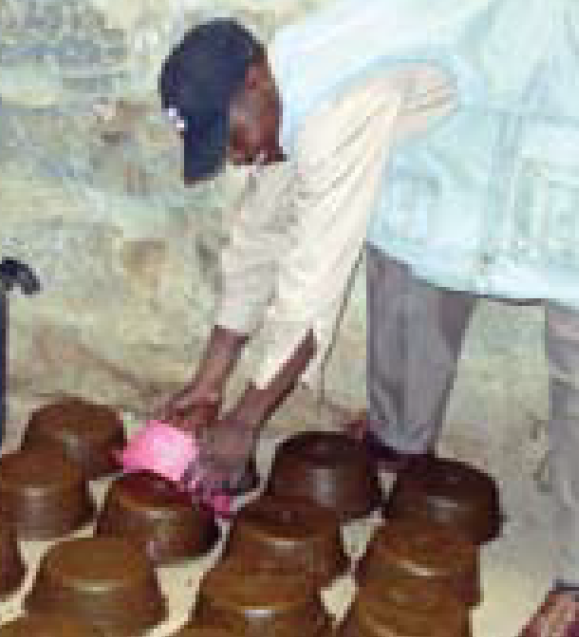
MEDICINAL BLOCKS
Kenya Agricultural Research Institute, P.O. Box 57811-00200, NAIROBI. Tel: 254-20-4183301-20, Fax: 254-20-4183344, Email: resource.centre@kari.org Website: www. kari.org, Compiled by : Mugambi, J.M. Nginyi J.M. and Rugutt, M.K.For more information contact: Centre Director, KARI Muguga North P.O BOX 32 Kikuyu, 00902 Tel: (066) 32106/7, 32000 Fax: (066) 32450 E Mail: vrckari@yahoo.com

Introduction
Medicated feed blocks are high energy feed and mineral supplement blocks which contain an anthelmintic or dewormer. They are made from affordable and readily available materials. The blocks are not commercially available in Kenya currently but the technology for making them is readily available.
Benefits of medicated feed blocks
Medicated feed blocks provide supplementary nitrogen, minerals and energy to the animals. This is particularly useful in times of prolonged feed shortage, as occurs in the arid and semi-arid areas of Kenya. The use of medicated feed blocks enables animals to survive this period by alleviating pathological effects of chronic helminth infections. In areas with continuous rainfall, use of these blocks prevents constant re-infection with worms which would otherwise necessitate regular and frequent use of dewormers. The blocks reduce possibility of anthelmintic resistance associated with frequent drug use.
Materials required
Molasses, Urea (fertiliser grade), Mineral premix, Maize germ (or other bulking agent), Cement, Common table salt, Anthelmintic (for medicated blocks)* and Water
* 1 x 100 kg cattle dose of a benzimidazole anthelmintic per kg of ingredients. The most preferred drugs include Zerofen and Panacur.
How to make medicated feed blocks
The technique is the same as that of making concrete blocks. Ingredients should be thoroughly mixed, preferably using a concrete mixer or a similar equipment. How to make 20 Pcs of 5 kg blocks is as follows:
Step 1
Pour 5 litres of water in a concrete mixer and add 10 kg of urea in the running concrete mixer. Run the mixer
until all the urea is dissolved.
Step 2
Add 1 litre of the anthelmintic (a 10% formulation of the appropriate drug e.g. Zerofen, Panacur).
Step 3
Weigh out 12 kg of cement and slowly mix in 3 litres of water until a homogeneous paste is attained. Pour this into the running mixer and add 3 kg of common salt and 5 kg of mineral premix.
Step 4
Measure out 25 kg of molasses and put in the running mixer. Use 2 litres of hot water to rinse the cement and molasses containers and add this to the mixer.
Step 5
Measure out 35 kg maize germ or any other bulking agent and put this in the concrete mixer. Let the mixer run until the thick paste is homogeneous. The resulting paste is ready for molding into any preferred shapes and sizes.
Step 6
Oil the inside of the moulding bowls or other suitable mould for ease of removal of the blocks after setting. Any edible salad oil can be used for this purpose. Pour the paste into 20 moulds of 5 kg each. The blocks should be left in the sun for about two hours. After this, they should be removed from the moulds and left to dry indoors for 1-2 weeks depending on the weather.
Some precautions when using blocks
If animals (especially sheep) consume too much of the blocks at once they can suffer from urea poisoning. It is important that blocks are introduced gradually and that the consistency is not too soft otherwise animals may eat too much.
Suspending the blocks instead of putting them on a flat surface also discourages animals from biting on the block.
Presentation of blocks to animals
The blocks are highly palatable and should be offered in a suspended position so that animals can only lick but not bite on the block.
Medicated blocks are mostly effective against new infections. It is therefore advisable to drench the animals first with a conventional drench before introducing the blocks.
